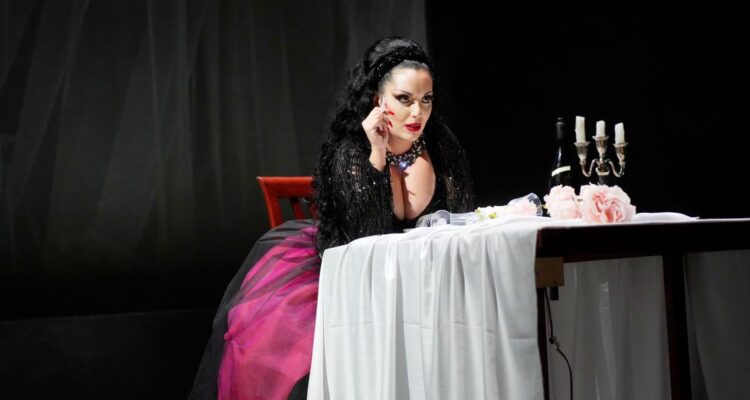Ermione is the sixth of nine operas Rossini composed for the San Carlo in Naples and one of the biggest flops of his career, with only three full performances. Critics found it overly loud and dominated by a single emotion—anger. After its 1819 failure, Ermione was largely forgotten, revived only once, and much of its music was repurposed for Eduardo e Cristina a month later.
The opera, based on Racine’s Andromaque, tells the story of a chain of unrequited love. Oreste (son of Agamemnon) loves Ermione (daughter of Menelaus and Helen), but Ermione is engaged to Pirro, King of Epirus and son of Achilles. However, Pirro is in love with Andromaca, widow of Hector, who is solely focused on protecting her son, Astyanax, from being handed over to the Greeks. Pirro, who holds Astyanax captive, offers Andromaca a choice: marry him and raise Astyanax as his heir, or let the boy be executed. When Pirro rejects Ermione for Andromaca, Ermione, in a fit of rage, convinces Oreste to kill Pirro, promising to marry him in return. After the murder, however, she furiously denounces Oreste, who is dragged away by the Greeks.
Ermione stands out musically. The overture is interrupted by a chorus of Trojan prisoners lamenting their fate. Isabella Colbran, Rossini’s future wife, was given the bulk of the vocal writing, and the role of Ermione dominates Act 2. Her Gran Scena is the longest and most involved of any 19th-century opera, and it concludes with a gripping final duet with Oreste.
The opera also touches on controversial themes. While Ermione revolves around regicide, Eduardo e Cristina, which borrows much of Ermione‘s music, celebrates absolute fidelity to the King. The subject of regicide was scandalous, especially when personal passion eclipsed royal duty, as seen later in Verdi’s Ballo in Maschera. Rossini recognized that Ermione was ahead of its time, stating that it would “only see the light of day after my death.” Indeed, the music anticipates the works of Bellini, Verdi, Meyerbeer, and Wagner. It wasn’t until the Rossini Opera Festival’s (ROF) 1987 revival that the opera returned to the stage.
The current production at the Vitrifrigo Arena is grand in scale, with a minimalistic set of three rectangles, neon lights, and side projections. The powerful music demands exceptional singing. However, the production is somewhat cluttered with distracting elements such as constant appearances by Cupid and figures in black. A clearer focus on the singers and the music would have better served the performance, given the supreme vocal demands of this opera.
Italian soprano Anastasia Bartoli as Ermione steals the show. From her first entrance, her dramatic voice and expressive singing captivate the audience, particularly in her Act 2 scenes. She delivers fiendishly difficult music with emotional intensity, making her character fully believable. Her vocal palette is wonderfully expressive, and her performance is a tour de force.
Spanish tenor Juan Diego Flórez as Oreste also handles his demanding role with superb bel canto technique, particularly in his duets with Bartoli, which are musical highlights of the performance. Enea Scala as Pirro impresses with his top notes and captures the character’s mercurial nature, while Victoria Yarovaya as Andromaca possesses a rich mezzo sound with a particularly strong lower register.
In conclusion, this is a sensational performance of Ermione. The opera’s fantastic, intense music and world-class singing confirm Rossini’s belief that it was ahead of its time—now, it is finally receiving the recognition it deserves.
ROSSINI OPERA FESTIVAL (ROF) 2024
OPERA TRAGICA IN TWO ACTS
Music by Giachino Rossini (1792-1868)
Libretto Andrea Leone Tottole after Racine’s play Andromaque.
Conducted by Michele Mariotti
Directed by Johannes Erath
First performance Teatro di San Carlo, Naples, 27 th March 1819
Photo Credit Amati Bacciardi
Cast includes Anastasia Bartoli, Victoria Yarovaya, Enea Scala, Juan Diego Flórez,Antonio Mandrillo,
Michael Mofician, Martiniana Antonie, Paola Leguizamón, Tainxuefei Sun
Running time 2 hours 55 minutes with interval

